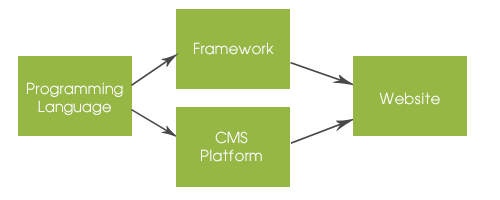

After a number of years, the web development industry is in a mature state. There are however a massive array of different solutions out there which range from different programming languages to different platforms within those programming languages.
Firstly, let’s talk about the languages and which is the best solution for you. There are tens of different ones for website development, but the three that really stand out are PHP, ASP.NET and Ruby.
ASP is Microsoft's offering and is built on the standardised C language which has been used for many years for PC software. Unlike many languages in web development, the Microsoft offering costs money with licensing. As a result, it's dwindling popularity over the years is nothing new. Nowadays, it is more reserved for very high end customers whose internal systems rely in Microsoft platforms.
PHP on the other hand is a completely open source system. Originally both ASP and PHP were competing against each other for market share, now years later PHP is a vastly dominant force. We did mention that ASP.NET is often the choice for large blue chip companies. However, PHP also has its share of high profile companies in its usage portfolio. Major sites like Facebook, Wikipedia and Match.com all use PHP as their language of choice.
Finally, Ruby is now gaining popularity among the web development community. The language though has grown up in an already crowded market place so it is doubtful it’ll ever get to the level that PHP has achieved. One big site that uses Ruby is Group on.
So we have discussed the main languages. Obviously, there are more but the above are the ones that really should be looked at for any web application. Let’s talk about Frameworks and how they can help aid development. A framework is a set of libraries (essentially templates) that can be used to carry out functions and features. These can then be re-used within a project to speed up the development life cycle.

All the main languages have an array of different frameworks available. The main framework that is currently gaining some real momentum is Drupal. Drupal isn’t just a framework, it’s also a CMS system too. The beauty of Drupal is that it is fully extendable and customisable to your customer’s requirements. There is however a learning curve associated with the CMS system and it’s not as user friendly as some of the other options out there.
One drawback of Frameworks are that they are more likely to become obsolete at some stage in the future. That is why if you are going down the Framework route, you choose one that has a good market share and has a larger volume of users.
Another option is to go bespoke. Developing bespoke web solutions using a language that is coded manually is by far the best way to go. If you’re looking to create a CMS (Content Management System) and don’t want to be tied down to anything this is by far the best solution.
There is one other aspect which we should talk about and that is off the shelf Content Management Systems. The most known ones are Wordpress and Joomla. Again, these are also based on the languages discussed above (these examples are actually written in PHP). Wordpress and alike can be great for some sites that do not require much flexibility. However, once you pass a certain threshold of changes, they can be an absolute nightmare to use. There are many great plugins available but as soon a customer requests a feature that is outside of the scope of what can be achieved, it’s virtually impossible to incorporate it.
After many years of doing web design and development it becomes very apparent that a bespoke solution with virtually unlimited features and flexibility will always win out.
The page threw up an unspecified error - please try again
Confirm
0 Comment(s)